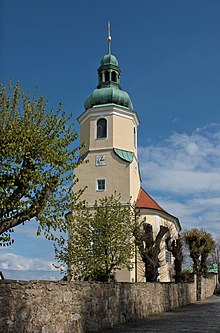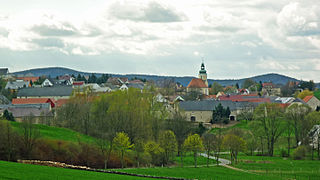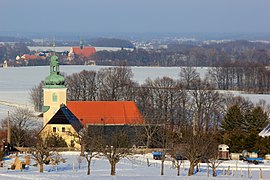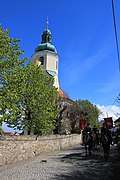Ostro
|
Ostro
Wotrow Community Panschwitz-Kuckau
Coordinates: 51 ° 13 ′ 1 ″ N , 14 ° 11 ′ 32 ″ E
|
|
|---|---|
| Height : | 196 m above sea level NHN |
| Residents : | 278 (Dec. 31, 2016) |
| Incorporation : | January 1, 1994 |
| Postal code : | 01920 |
| Area code : | 035796 |
Ostro , Upper Sorbian , is a village in the eastern Saxon district of Bautzen . It is part of Upper Lusatia and is located in the core settlement area of the Sorbs . The village, which belongs to the Panschwitz-Kuckau community , has 271 inhabitants and is one of the oldest documented settlements in Upper Lusatia. The majority of the residents speak Sorbian as their mother tongue.
location
Ostro is located in the southwest of Upper Lusatia, about five kilometers east of Elstra and a good two kilometers south of Panschwitz-Kuckau. The place belongs to the "Oberland" ( Horjany ) of the former monastery maintenance of St. Marienstern and is located on the western slope of the Klosterwasser valley. The Ostroer Schanze rises on the other side of the river. The place is between 183 and 220 meters above sea level.
history
There is a well-preserved prehistoric ski jump near the village . It was created by people of the Iron Age Billendorfer culture about 2500 years ago. The Sorbs took possession of the remains of the fortifications, which had been abandoned by the 4th century at the latest, when they settled in the Upper Lusatia region in the 8th century. During this time the hill was rebuilt in a smaller version. With an area of 2.5 hectares, this large castle was apparently the main town of the Milzen family before it was replaced by Bautzen . Coming from the later Kamenz , the surrounding area was crossed by the routes of the Via regia . In the 12th century the castle had survived and could no longer be held. It was replaced by a tower hill fortification 150 m southeast.
From 1076 to 1559 the village belonged to the parish of Göda . When the Reformation was introduced in the parish church of Göda, the residents of Ostro remained Catholic and after lengthy disputes between the Protestant estates of Upper Lusatia and the Saxon Elector on the one hand and the St. Petri Cathedral in Bautzen as local rule on the other, they became Catholic Assigned to the parish of Crostwitz.
In 1755, Bishop Jakob Wosky von Bärenstamm bought a farm in the village and had a rectory built. Ostro became an independent parish. In 1772 the construction of the St. Benno Church was completed. Bishop Wosky also founded the Ostroer School in 1764. The original building was replaced by a new one in 1836, but it collapsed in 1841. The school house built the following year was given an extension in 1925. Today the school house serves as a meeting point for the village community.
In 1910 Ostro had 287 inhabitants; Almost all of them stated Sorbian as their mother tongue in the Saxon census carried out this year.
The important Sorbian poet Jakub Bart-Ćišinski was buried in the Ostroer cemetery in 1909. A memorial erected there in 1969 commemorates him.
Until 1994 Ostro was an independent rural community with the districts Neustädtel (from July 1, 1950), Cannewitz and Säuritz (from 1974). Then it was incorporated into Panschwitz-Kuckau.
Place name
Ernst Eichler and Hans Walther derive the place name from the Old Slavic word for "island" or " Werder " (cf. Czech ostrov ). This interpretation takes into account the location of Ostro Castle high above the monastery water, which flows around it on three sides.
Population and language
For his statistics on the Sorbian population in Upper Lusatia, Arnošt Muka determined a population of 258 in the 1880s, including all Sorbs. In 1956 Ernst Tschernik counted a Sorbian-speaking population of 85.2% in the municipality of Ostro (with Neustädtel).
Personalities
- Georg Wuschanski - Sorbian Jurij Łusčanski - (1839–1905); Apostolic Vicar of Saxony, titular bishop of Samos and dean of the Bautzen cathedral monastery.
- Józef Nowak (1895–1978); Sorbian pastor
gallery
See also
Individual evidence
- ↑ Information for 2014 from am-klosterwasser.de
- ↑ Ernst Eichler and Hans Walther : Ortnamesbuch der Oberlausitz. Akademie-Verlag, Berlin 1975
- ↑ Ernst Tschernik: The development of the Sorbian population . Akademie-Verlag, Berlin 1954, p. 99 .
- ^ Ludwig Elle: Language policy in the Lausitz . Domowina-Verlag, Bautzen 1995, p. 251 .
literature
- Werner Coblenz : Ostro and his ski jump . (= Publications of the Museum der Westlausitz Kamenz , special issue). Kamenz 1991. ISBN 3-910018-08-4 .
- Jan Meškank : Wotrow a wokolina. Přinošk k wjesnej chronice. Budyšin 1958.
- Reinhard Spehr : Christianization and the earliest church organization in the Mark Meissen. An attempt . In: Judith Oexle (ed.): Early churches in Saxony. Results of archaeological and architectural studies (publications by the State Office for Archeology and State Museum for Prehistory 23) Stuttgart 1994, pp. 8–63. ISBN 3-8062-1094-2 .
- Cornelius Gurlitt : Ostro. In: Descriptive representation of the older architectural and art monuments of the Kingdom of Saxony. 35. Issue: Amtshauptmannschaft Kamenz (Land) . CC Meinhold, Dresden 1912, p. 268.
Web links
- Ostro in the Digital Historical Directory of Saxony
- Ostro on the website of the Cyrill Methodius Association ( Memento from September 4, 2009 in the Internet Archive )







